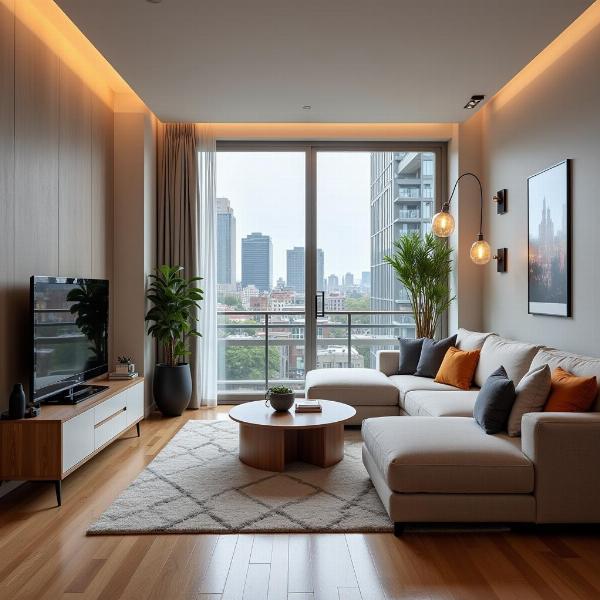Common room. A phrase that evokes images of shared spaces, conversations, and community. But what exactly does it mean in Hindi, and how is it used in different contexts? This article will delve into the various Hindi translations of “common room,” exploring their nuances and cultural significance. We’ll also look at how this concept manifests in Indian society, from educational institutions to residential settings.
Understanding “Common Room” in Different Contexts
The meaning of “common room” can vary depending on the situation. In an educational setting, it often refers to a shared space for students to relax and socialize. In a residential building, it might denote a shared lounge area for residents. The Hindi translation, therefore, must reflect this contextual variation.
Common Room in Educational Institutions
In schools and universities, the “common room” is a vital part of student life. It provides a space for students to unwind between classes, meet friends, and engage in extracurricular activities. A suitable Hindi translation in this context could be “सामान्य कक्ष” (sāmānya kakṣa), which literally translates to “common room.” However, more colloquial terms like “विद्यार्थी कक्ष” (vidyārthī kakṣa – student room) or “मिलन कक्ष” (milan kakṣa – meeting room) are often used.
Common Room in Residential Buildings
In apartments or hostels, the “common room” serves as a shared living space for residents. It allows them to interact, watch television, or simply relax. Here, the Hindi translation might be “सामूहिक कक्ष” (sāmūhik kakṣa – collective room) or “बैठक” (baithak – sitting area). Sometimes, the more informal term “हॉल” (hāl – hall) is also used.
 Common Room in an Apartment
Common Room in an Apartment
Cultural Significance of the Common Room in India
The concept of a shared space for social interaction holds a significant place in Indian culture. Traditionally, joint families lived together, and the courtyard or “आँगन” (āṅgan) served as a central gathering point. The common room in modern settings can be seen as an extension of this tradition, fostering a sense of community and belonging.
Common Room Etiquette in India
While the concept of a common room is widely accepted, certain etiquette is observed. Respect for others, maintaining cleanliness, and keeping the noise level down are generally expected. These unspoken rules contribute to a harmonious atmosphere in shared spaces.
What Does “Common Room” NOT Mean in Hindi?
It’s important to clarify that “common room” doesn’t translate to terms that imply exclusivity or private ownership. For instance, “निजी कक्ष” (nijī kakṣa – private room) or “व्यक्तिगत कक्ष” (vyaktigat kakṣa – personal room) are incorrect translations.
Conclusion: Finding the Right Translation for “Common Room”
The most appropriate Hindi translation for “common room” depends heavily on the context. While “सामान्य कक्ष” (sāmānya kakṣa) provides a literal translation, more colloquial terms like “विद्यार्थी कक्ष” (vidyārthī kakṣa), “मिलन कक्ष” (milan kakṣa), “सामूहिक कक्ष” (sāmūhik kakṣa), or “बैठक” (baithak) might be more fitting depending on the specific situation. Understanding these nuances is crucial for accurate communication and cultural sensitivity.
FAQ:
-
What is the most common Hindi word for “common room”? The most common and literal translation is “सामान्य कक्ष” (sāmānya kakṣa).
-
Is “हॉल” (hāl) an acceptable translation for “common room”? Yes, “हॉल” (hāl) is often used informally to refer to a common room.
-
What is the cultural significance of common rooms in India? Common rooms reflect the Indian tradition of shared spaces for social interaction, fostering a sense of community.
-
What are some examples of common room etiquette in India? Respecting others, maintaining cleanliness, and keeping the noise levels down are important aspects of common room etiquette.
-
What are some incorrect Hindi translations of “common room”? Terms implying exclusivity, such as “निजी कक्ष” (nijī kakṣa) or “व्यक्तिगत कक्ष” (vyaktigat kakṣa), are incorrect translations.
Meaning-Hindi.in is your one-stop solution for all your Hindi translation needs. We offer a wide range of professional translation services, including business and commercial document translation, certified and legal document translation, technical and user manual translation, website and localization translation, educational and academic document translation, express translation, and specialized translation. For a free quote, contact us at [email protected] or call us at +91 11-4502-7584. Meaning-Hindi.in is committed to providing accurate, culturally sensitive, and high-quality translations to bridge the language gap and facilitate effective communication.